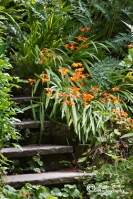 The garden takes its name from a magnificent landmark tree (probably a Wych Elm) that stood on this site as early as the 10th century. The origin of the word ‘Larmer’ is so ancient that it can only be guessed at. Originally spelt Lavermere, ‘Mere’ would certainly mean a boundary, while ‘Laver’ might have come from the Anglo-Saxon ‘Laur’, perhaps meaning Laurel. King John (1189-1216) hunted in this area many times and tradition states he met with his huntsmen under the branches of the Larmer Tree.
The garden takes its name from a magnificent landmark tree (probably a Wych Elm) that stood on this site as early as the 10th century. The origin of the word ‘Larmer’ is so ancient that it can only be guessed at. Originally spelt Lavermere, ‘Mere’ would certainly mean a boundary, while ‘Laver’ might have come from the Anglo-Saxon ‘Laur’, perhaps meaning Laurel. King John (1189-1216) hunted in this area many times and tradition states he met with his huntsmen under the branches of the Larmer Tree.
 In 1880, General Augustus Lane Fox inherited the Rushmore Estate, a condition of the will being that he change his name to Pitt Rivers. General Pitt Rivers almost immediately set about creating the Larmer Tree Pleasure Grounds, which by 1899 were attracting over 44,000 visitors a year. Surrounding the main lawn he constructed a variety of buildings intended to enlighten and educate his estate workers and visitors. For those visitors wishing to picnic there were eight areas, known as quarters, each was enclosed by laurel hedges and contained a thatched building for shelter.
In 1880, General Augustus Lane Fox inherited the Rushmore Estate, a condition of the will being that he change his name to Pitt Rivers. General Pitt Rivers almost immediately set about creating the Larmer Tree Pleasure Grounds, which by 1899 were attracting over 44,000 visitors a year. Surrounding the main lawn he constructed a variety of buildings intended to enlighten and educate his estate workers and visitors. For those visitors wishing to picnic there were eight areas, known as quarters, each was enclosed by laurel hedges and contained a thatched building for shelter.
Music and entertainment were very much associated with the gardens. The Singing Theatre was used for plays and poetry recitals and in the field adjoining the gardens there was a racecourse, lawn tennis courts and an eighteen-hole golf links. In the evening the gardens were illuminated with thousands of Vauxhall lights, and there was dancing in the open air. “Quite the prettiest sight I ever saw in my life” is how Thomas Hardy described it in 1895.
 Following the General’s death in 1900 the gardens closed, opening only occasionally for specific events. In 1991 Michael Pitt Rivers, the General’s great grandson, set about restoring the gardens, in the period the garden had been closed many of the buildings had been lost and laurel had swamped all but the main lawn. In 1995, these extraordinary gardens were reopened to the public. In December 1999, shortly before his death Michael Pitt Rivers planted a new Larmer Tree to mark the new millennium.
Following the General’s death in 1900 the gardens closed, opening only occasionally for specific events. In 1991 Michael Pitt Rivers, the General’s great grandson, set about restoring the gardens, in the period the garden had been closed many of the buildings had been lost and laurel had swamped all but the main lawn. In 1995, these extraordinary gardens were reopened to the public. In December 1999, shortly before his death Michael Pitt Rivers planted a new Larmer Tree to mark the new millennium.

